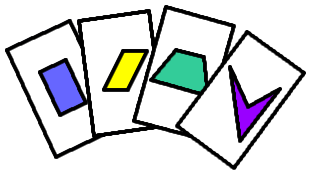Or search by topic
Number and algebra
Geometry and measure
Probability and statistics
Working mathematically
Advanced mathematics
For younger learners
Quadrilaterals Game



Quadrilaterals Game printable sheet - instructions
Quadrilaterals Game printable sheet - cards
This is a game for 2 or more players. You will need a set of cards; you can get a copy to print here.
Shuffle the cards well.

Now deal 8 to each player (face down), and place the rest in a pile in the middle of the table, again all face down. Turn over the top card of the stack onto the table (face up): this forms the discard pile. You can look at your own cards, but not those of anyone else.
Your aim is to make two 'tricks', where each trick has to consist of a picture of a shape, a name that describes that shape, and two properties of the shape. For example, you might have a picture of a kite, the word 'kite', and then two properties of a kite. But you could also have a picture of a kite, the word 'quadrilateral', and then two properties of a kite.
This game is based on the game Quadrilateral Rummy from "Geometry Games", a photocopiable resource produced by Gillian Hatch and available from the Association of Teachers of Mathematics
You may also like
Linkage
Four rods, two of length a and two of length b, are linked to form a kite. The linkage is moveable so that the angles change. What is the maximum area of the kite?
Making Rectangles, Making Squares
How many differently shaped rectangles can you build using these equilateral and isosceles triangles? Can you make a square?
The Cyclic Quadrilateral
This gives a short summary of the properties and theorems of cyclic quadrilaterals and links to some practical examples to be found elsewhere on the site.

